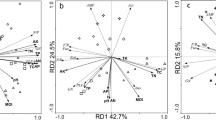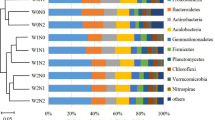Abstract
The effects of soil moisture changes on bacteria, fungi, protozoa, and nematodes and changes in oxygen consumption were studied in a field experiment. In one plot the soil was drip-irrigated daily for 10 days, while an adjacent plot experienced one rainfall and was then allowed to dry out. Oxygen consumption was the parameter measured which responded most rapidly to changes in soil moisture content. Lengths of fluorescein diacetate-active hyphae paralleled oxygen consumption in both plots. Total hyphal length was not affected by one rainfall but increased from 700 mg−1 dry weight soil to more than 1,600 m in less than 10 days in the irrigated plot. In the rain plot, bacterial numbers doubled within 3 days and declined during the following period of drought. In the irrigated plot, numbers increased by 50% and then remained constant over the duration of the study. Only small changes in protozoan numbers were observed, with the exception of the last sampling date in the irrigated plot when large numbers of naked amoebae were recorded 2 days after a large natural rainfall. Nematode numbers, especially obligate root feeders, increased in both treatments. The increases were caused by decoiling rather than growth. The results indicate that fungal respiration was dominating, while bacteria, lacking a suitable source of energy, were less active, except for the first days.
Similar content being viewed by others
References
Bååth E, Söderström B (1982) Seasonal and spatial variation in fungal biomass in a forest soil. Soil Biol Biochem 14:353–358
Bakken LR, Olsen RA (1983) Buoyant densities and dry matter contents of microorganisms in conversion of a measured biovolume into biomass. Appl Environ Microbiol 45:1188–1195
Barber SA (1977) Nutrients in soil and their flow to plant roots. In: Marshall JK (ed) The belowground ecosystem: a synthesis of plant-associated processes. Range Science Department Science Series No. 26. Colorado State University, Fort Collins, pp 161–168
Chakraborty S, Old KM (1982) Mycophagous soil amoeba: interactions with three plant pathogenic fungi. Soil Biol Biochem 14:247–255
Clarholm M (1981) Protozoan grazing of bacteria in soil—impact and importance. Microb Ecol 7:343–350
Clarholm M, Rosswall T (1980) Biomass and turnover of bacteria in a forest soil and a peat. Soil Biol Biochem 12:49–57
Demeure Y, Freckman DW, Van Gundy SD (1979) Anhydrobiotic coiling of nematodes in soil. J Nematol 11:189–195
Griffin DM (1980) Water potential as a selective factor in the microbial ecology of soils. In: Water potential relations in soil microbiology. Soil Science Society of America, Madison, pp 142–151
Hurst HM, Wagner, GH (1969) Decomposition of14C-labelled cell wall and cytoplasmic fractions from hyaline and melanic fungi. Soil Sci Soc Amer Proc 33:707–711
Jones PCT, Mollison JE (1948) A technique for the quantitative estimation of soil microorganisms. J Gen Microbiol 2:54–69
Lynch JM (1976) Products of soil microorganisms in relation to plant growth. Critical Reviews in Microbiology 5:67–107
Mankau R, Mankau SK (1963) The role of mycophagous nematodes in the soil. In: Doeksen J, van der Drift J (eds) Soil organisms. Proceedings of the colloquim on soil fauna, soil microflora and their relationships. Oosterbeek, The Netherlands, pp 271–280
Nannipieri P, Pedrazzini F, Arcara P, Piovanelli C (1979) Changes in amino acids, enzyme activities and biomasses during soil microbial growth. Soil Science 127:24–26
Olson FCW (1950) Quantitative estimates of the filamentous algae. Trans Am Microscop Soc 69:272–279
Parker LW, Freckman DW, Steiberger Y, Drigger L, Whitford WG (1984) Effects of simulated rainfall and litter quantities on desert soil biota: soil respiration, microflora and protozoa. Pedobiol 27:185–195
Paustian, K (1985) Influence of fungal growth pattern on decomposition and nitrogen mineralization in a model system. Ecological interactions in soil in plants, microbes and animals. In: Fitter AH, Atkinson D, Reid DJ, Usher MB (eds) British Ecological Society special publication No 4, Blackwell, Oxford, pp 159–173
Rosswall T, Lohm U, Sohlenius B (1977) Développement d'un microcosme pour l'étude de la lázote dans l'humus d'une forêt conifères (Pinus sylvestris L.). Lejeunia N.s. 84:1–24
Schnürer J, Clarholm M, Rosswall T (1982) Microorganisms: In: Rosswall, T (ed) Progress Report 1981. Ecology of arable land. The role of organisms in nitrogen cycling. Swedish Univ Agr Sci, Uppsala, pp 77–88
Shields JA, Paul EA, Lowe WE (1973) Turnover of microbial tissue in soil under field conditions. Soil Biol Biochem 5:753–764
Söderström BE (1977) Vital staining of fungi in pure culture and in soil with fluorescein diacetate. Soil Biol Biochem 9:59–64
Sohlenius B (1979) A carbon budget for nematodes, rotifers and tardigrades in a Swedish coniferous forest soil. Holarct Ecol 2:30–40
Sohlenius B, Wasilewska L (1984) Influence of irrigation and fertilization on the nematode community in a Swedish pine forest soil. J Appl Ecol 21:327–342
Steen E, Jansson P-E, Persson J (1984) Site description of the experimental field of the “Ecology of Arable Land” project. Acta Agric Scand 34:153–166
Steinberger Y, Freckman DW, Parker LW, Whitford WG (1984) Effects of simulated rainfall and litter quantities on desert soil biota: nematodes and microarthropods. Pedobiol 26:267–274
Stotzky G, Norman AG (1963) Factors limiting microbial activities in soil. III. Supplementary substrate additions. Can J Microbiol 10:143–147
Trolldenier G (1972) Fluoreszensmikroskopische Zählung von Bodenbakterien. I. Historischen überblick und Beschreibung eines Verfahren zur Zählung von Bodenbakterien in Trockenpräparaten. Zentralblatt für Bakteriologie. II. 127:25–40
Whitford WG, Freckman DW, Elkins NZ, Parker LW, Parmalee R, Phillips J, Tucker S (1981) Diurnal migration and responses to simulated rainfall in desert soil microarthropods and nematodes. Soil Biol Biochem 13:417–425
Yeates GW (1978) Populations of nematode genera in soils under pasture. In: Seasonal dynamics in dryland and irrigated pastures on a southern yellow-grey earth. NZJ Agric Res 21:321–330
Author information
Authors and Affiliations
Rights and permissions
About this article
Cite this article
Schnürer, J., Clarholm, M., Boström, S. et al. Effects of moisture on soil microorganisms and nematodes: A field experiment. Microb Ecol 12, 217–230 (1986). https://doi.org/10.1007/BF02011206
Issue Date:
DOI: https://doi.org/10.1007/BF02011206




